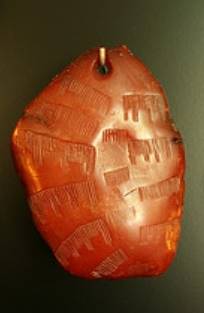The problem of safe storage is especially important for tiny pieces of amber, since many factors, mostly light and atmospheric oxygen cause degradation of amber, starting from its surface. There is an extended study on the mechanisms of amber degradation.
In the beginning of our work with tiny amber preparations, the idea of water storage looked the most promising: the mesolithic amber pendant recovered from the peat bog shows very little signs of deterioration.
It was found soon that some preservative substance must be added to prevent fungal and bacterial grouth. We use thymol for this purpose.
Another benefit of water storage is that minute inclusions become water-filled through diffusion, which greatly enhances visibility of their fine details (see discussion in Sidorchuk & Norton (2011)).
The vial containing the amber specimen in water must be tightly sealed (using Parafilm solves the possible problems) and kept at dusk and a low, stable temperature.


